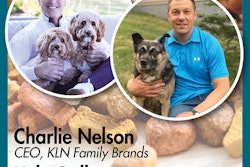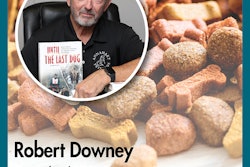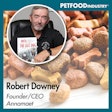
In this episode of Trending: Pet Food, Lindsay Beaton speaks with Hunter Ellis, brand experience strategist at Trone, about the concept of a brand compass and why pet food companies should know about it. Ellis explains that a brand compass is an internal strategic document that serves as a North Star for brands, containing key elements like brand purpose, universal audience needs, brand archetype, tangible and intangible brand aspects, and proof points.
We want to thank Rangen Pet Nutrition for sponsoring this podcast. Rangen Pet Nutrition is your trusted partner in advancing pet health. From antioxidants to custom premixes and pure yeast solutions, they help pet food companies create superior nutrition with innovative science and dependable expertise. Learn more on LinkedIn at Rangen Pet Nutrition.
Lindsay Beaton, editor, Petfood Industry magazine and host, Trending: Pet Food podcast: Hello, and welcome to Trending: Pet Food, the industry podcast where we cover all the latest hot topics and trends in pet food. I'm your host and editor of Petfood Industry magazine Lindsay Beaton, and I'm here today with return guest Hunter Ellis, brand experience strategist at Trone. Hi Hunter, and welcome!
Hunter Ellis, brand experience strategist at Trone: Hey, Lindsay. It's great to be here again.
Beaton: In case you're unfamiliar with Hunter or Trone, here's what you need to know.
With over 10 years of account planning experience, Hunter helps Trone strengthen clients' brand stories by researching cultural trends and conducting research to create authentic relevance for memorable veterinary and retail pet campaigns. He works with creatives, brand planners and digital marketers to keep the strategy and story consistent.
Trone is a branding and marketing agency dedicated to helping brands with heart find and inspire people who share their passion and have real needs to fill. As the agency has evolved with the industry to expand its digital innovation, Trone remains an insight-driven agency that bases recommendations on a strong strategic foundation.
Hunter's in-depth knowledge of pet marketing and branding are why I've brought him back today to answer this question: What is the concept of a "brand compass," and why should pet food companies know about it?
Hunter, with these types of conversations, I always end up doing the 101 question, just to make sure everybody is on the same page. Right off the bat, what is a brand compass, and how does it relate to the idea of a brand purpose, something that companies are going to be more familiar with?
Ellis: That's an excellent question, Lindsay. A brand compass is an internal strategic document that's typically going to be used by marketers. It could be used by sales team and sales staff, but it's an internal strategic document that contains all those key strategic elements that provide focus and direction. You can almost think of a brand compass as a North Star for a brand. It contains several elements, typically one to two pages of a document that can be referenced, and brand purpose is at the top of the brand compass. A brand belief, or some kind of core company value that the brand stands for, might be partly why the brand was founded in the very first place. It might be why the brand has evolved with the times to solve a need. That is typically going to be at the very top of a brand compass document. I would say brand purpose is the key foundational point of the brand compass document.
Beaton: Now we're going to get into all the elements of a brand compass document and how they play into a marketing strategy and a brand strategy. But first, is brand compass something you guys came up with, or is this an evolving strategy in the marketing space overall?
Ellis: I would love to be able to say that Trone came up with the brand compass, but it's a document we were first exposed to with a large Fortune 500 company. This is a company that is in the pet space, that has large number of resources, large team, and lots of regular turnover. The brand compass was a way that they could set some sort of foundation of a playbook that everyone is able to reference and speak to. We have found that it also works well with smaller clients or independent clients, or clients that are more of a startup, ones that haven't really been around or have that legacy. We didn't necessarily come up with the brand compass, but we are advocates for the use of brand compasses for pet brands and pet clients.
Beaton: Let's dive into the brand compass document. We talked about brand purpose, which you said is the North Star of a brand compass. What are the other elements involved, and which ones are easy for companies to get through, and which ones are more challenging? I'm always interested to see where the roadblocks are.
Ellis: I'll say this: a brand compass, there's no one way to create it. You kind of build it based on the needs of the brand. But typically, you're going to start with some big brand belief or brand purpose statement, a statement that is two feet in the present day, current state of things, one foot in the future, or aspirational future for the brand. It's got to be foundational to the brand identity and the brand story. From that, you want to include a universal audience need. No matter which audiences you currently speak to or hope to speak to someday, what is that big need that the brand is helping solve or connecting to?
Then you want to figure out the archetype of the brand. How does the brand behave? What is the role of the brand in the marketplace? How do we want people to perceive the brand? We're going to figure out the archetype that's true of today, but also true of where we want to go. If this is our North Star, we want to chart not only how we want people to think about the brand today, but also what we want people to think about the brand down the road. Then we'll have all the intangible aspects of the brand, whether that's a logo, a color palette, a tagline, or maybe it's just some sort of feeling that we want to evoke or connect to the brand as much as we can whenever we are speaking about the brand out there in the marketplace, externally.
Then finally, to me, one of the most critical aspects of it all is, what are those proof points? What's the reason to believe this brand compass is true? Because you need evidence for these brand benefits, whether that's awards that the brand has won, whether that's key feedback, or whether it's some big campaign that was successful. What is out there that can be pointed to that makes that brand belief, that makes that archetype, that makes those tangible and intangible elements true? Because if you don't have that, it's going to be hard for anyone to believe this brand compass is worth speaking about or referencing time and time again.
Beaton: A lot of these sound like elements that companies probably already have an idea of but they might not have them all connected. Do you find when you're going through something like this with a company that they really do have those elements, and they just need them merged together? Or are there some gaps that you're seeing repeatedly where companies just are not thinking about that particular aspect as part of a branding strategy?
Ellis: That's a good question. I think it's going to depend. To me, I find this exercise, going through and really defining the brand compass, it's great to do it around the time of a major shift within the company, whether that's new leadership, whether that's some big marketing effort or new product reveal or release. Typically, that's going to be the time when people are most receptive to change or evolution of the brand and trying to get everything in line so that we have this consistency of voice and that the brand seems like it's confident and sure of itself.
A brand compass isn't necessarily a document that never changes. It's something I would say it's probably good for three to five years, depending on how frequently leadership changes are happening, acquisition activity is happening, major marketing efforts are happening. But that's kind of key. Do brands have a lot of these elements? They do. But I think the challenge is, are they aligned in the aspirational future? The thing with a lot of strategic planning marketing documents is they're really done with a short-term focus, or a short-term view of things. What's that trend that we need to tap into? What's that market fast leader that we want to go after?
Having the ability and the time to build a document that is meant to stand a little bit more of a longer-term perspective is important. If you can get everyone, at least decision makers, from both the agency side and the company or the brand side, aligned around what is our belief, what is our universal need, what is our reason to believe for all of this to be true, I think that's going to really help make decisions easier, because then all of a sudden you start to look at, does this partnership make sense? Does this new flavor make sense based on how we want people to perceive our brand today as well as over the next two to three years?
You asked earlier, Lindsay, about what's the most challenging aspect of the brand compass. I think in a lot of ways, it's the archetype. I think figuring out the behavior or the role of the brand can be hard to get alignment on. I think a lot of times, people want to be very innovative. They want to be a leader. They want to behave like what they perceive to be the number one product in the category might be. But that oftentimes isn't necessarily the best strategy or the strategy that will align with how customers currently perceive the brand, if the brand's not the market leader. Trying to come at it from a slightly different angle, or think about where do we want to be in two or three years as a brand? How do we want to be perceived? The archetype is hard. I think the reasons to believe can be hard, especially for startups and smaller brands who don't have a long legacy in the marketplace, figuring out how this is true if we haven't been around for as long as some of our competitors?
Beaton: It sounds like this document has the potential to fill a lot of different corporate needs. You mentioned that the Fortune 500 company uses it to keep everybody on the same page as leadership changes, as staff changes. In addition to using it as a marketing guiding light and a branding guiding light, who is coming to you normally to ask for help in putting something like this together? Is it the C suite or is the marketing team getting wind of this first and going, okay, we're tired of everybody not understanding our vision. Please help us put together a document that we can just wave in everybody's faces so that everybody internally knows what's going on. Who most benefits from this initially, and how does it spread to other parts of the company?
Ellis: I think it tends to be the VP of marketing or the Director of Marketing initially, because they have their own perspective on how to organize the brand, but then their board or their C suite has a very different view of how the brand should look, and what is our compass. The disconnect, that fundamental challenge between those two, is the reason why we say, okay, it sounds like we need to do a sync session. We need to get some of these decision makers together and talk through some of this, go through some of our exercises to map this out and determine how these pieces and parts of the brand connect to create some harmony. Because when you get all of this mapped out and working together, it is this document that each part of the organization, whether that is C suite, whether that is the marketing team, R&D, partnerships, media relations, these different departments can start to find that alignment and create that consistency.
Next thing you know, you're starting to live out that aspiration sooner than you thought it would take to get there, because this can be used to influence an internal company culture. If we want to be perceived as behaving like this, we need to behave like this internally. It can be used for internal training document purposes. I think it's a document that combines a lot of different thoughts into one story in a way that is aspirational and powerful, and it can be used in a variety of ways. I don't know that many brands are using it beyond marketing, but I think it has the potential to impact more aspects. I think it really helps make decisions easier or at least justify decisions or not.
Beaton: I want to dive into that a little bit more, because you mentioned that this kind of document can be particularly useful during a large shift to make sure things don't go off the rails. But you also mentioned small companies and how they can benefit from this as well. I can see in an industry that is made up of so many small and medium sized companies and new companies entering the market or trying to enter the market pretty much every day, that this could be a foundational document, something that a newer company in its first year in the industry puts together so that it doesn't lose its way in the vast ocean of the pet food industry. Have you worked with anybody who's used it as something like that?
Ellis: Brands that are launching in a new market or new territory, or even just smaller brands that have only been around maybe a year or less have utilized this document, not only as a way to set expectations for how they want this, basically to help establish their brand story, but also to allow them to be able to come back and reflect.
Two, three years down the road, they can say, “this is where we were, how much of this will need to evolve?” Because it becomes easier, in a way, to update the brand compass once you've built it out. It's not like you're going to have to redo all the thinking. Some of the thinking may still apply. Some of it may just need a little nuance as different initiatives and different focus areas for the company change. But overall, it's this great document that creates alignment, and you can go back to it and look at it from a historical perspective.
Beaton: We've talked a lot about the various ways you can implement this document internally, externally, inside facing, customer facing. How does something like this fit within the current landscape of marketing strategies, and how do you think it is going to integrate into strategies moving forward?
Ellis: One thing I think is undeniable is COVID-19. The pandemic drove people to reflect more on what their priorities are. Things have become more expensive. Petflation became something that may have entered the lexicon for pet parents. When you look to buy a brand name product you want to make sure that brand has a commitment to some sort of value or it represents your own personal values.
HubSpot last year did their future consumer trends report. They found that 82% of customers want to engage with and buy from brands that share their values. The whole purpose of this brand compass is to create alignment, not only with the brand's belief of where the company wants to head, but also connect to audience needs, to connect to a category, contextual insight. I think all of this is just pointing to the need more and more if you are a brand name product in this space, you need to figure out sooner rather than later, your values and how they have evolved, or how you want them to evolve to change perceptions around your brand.
I think, number one, it's not going away. I think customers, by and large, want brands to share their values, or they want to buy from brands that have values just point blank. The other is, and this is more of an internal thing, but as more and more brands shift in the age of AI towards feeding internal documents, internal data to help train AI, whether that's an assistant or a data analysis AI tool, having something like a brand compass that is fed to the AI, that can help the AI understand the company internally, from its core values to those key aspects and components of the brand, to why it's true, or why the reasons to believe can help impart that the AI is trained to look for opportunities that align with that, or that the AI can identify which products and which services align best to maintain this aspirational brand compass.
I think it's one of those documents that has some greater emphasis as the world shifts more and more towards AI that is understanding of a company's beliefs, values and behaviors.
Beaton: As we wrap up, I want to give people listening something to think about in terms of how a brand compass might fit well into the strategy that they're already using, and how it might be useful for them. Going forward, what is the top element of a brand compass that you have found companies are most energized by or most surprised by, or get the most enlightenment from?
Ellis: The brand compass that I have been most familiar with, one of the elements is a brand benefit, which brings kind of rational and emotional brand experience to life. It combines a lot of the brand compasses typically into one two sentences. I think that if it's not completely based upon the existing brand story for the brand, I think it will go on to help change the brand story. Because the beauty of building all of this is it gives you that time to reflect on, is this true of who we are today? If it's not, we can adjust. We can make changes.
I think part of this is just the process of going through and building it, whether you have most of it already, or whether you're going to have to do a lot of work to get there. I think the idea that once you go through this process, there's kind of that aha moment within the brand, within the agency team to go, okay, we are energized. We have an excitement and energy that is true of today, but it's also true of where we want to go, and we know in the back of our heads if at any point an opportunity presents itself that feels too good or maybe it feels a little off, we've got this document. We've got this brand compass that we can refer to and make sure. It's nice just knowing it's there and that it can be referred to. It's easy to pull up in any kind of meeting situation, because it's meant to be one page. It's easy to refer to and ask, “Is this really true of who we are and where we want to go?” That’s powerful. That's the thing, the brand benefit, but also just the whole process of building it can be very energetic.
Beaton: Well, thank you very much, Hunter for coming on again and continuing to talk about marketing and branding. I think if anybody listens to your previous episodes, you can hear the evolution of marketing and branding there over the last few years, and it's only becoming more complex and nuanced. Everybody's trying to differentiate. It's not getting any simpler. I think that the more companies are in tune with their own identities, the better they'll be able to differentiate no matter what the market is like. I really appreciate you coming on and just helping brands figure out how to do that.
Ellis: Thank you for having me.
Beaton: Before we go, I always do a little plug. Where can people find more information about you and Trone?
Ellis: Yeah, we're currently about to unveil our long, long overdue website redesign, but you can find us at Trone, trone.com. We've got a full list of all our capability services as well as disciplines. You can find me on LinkedIn, Hunter Ellis, brand experience strategist. If this process, or maybe it's been a while since the last brand compass exercise, or maybe you're just feeling like it's time to go through this process for your brand, whether that's a big one or a small one, reach out. We would love to help. It's not as involved as you might think, but it's also a very energizing and exciting process to go through.
Beaton: Perfect thanks, Hunter. That's it for this episode of Trending: Pet Food. You can find us on petfoodindustry.com, SoundCloud or your favorite podcast platform. You can also follow us on Instagram @trendingpetfoodpodcast. If you want to chat or have any feedback I'd love to hear from you, feel free to drop me an email [email protected].
Of course, thanks again to our sponsor, Rangen Pet Nutrition for sponsoring this podcast. Rangen Pet Nutrition is your trusted partner in advancing pet health. From antioxidants to custom premixes and pure yeast solutions, they help pet food companies create superior nutrition with innovative science and dependable expertise.
Once again, I'm Lindsay Beaton, your host and editor of Petfood Industry magazine, and we'll talk to you next time. Thanks for tuning in!

















